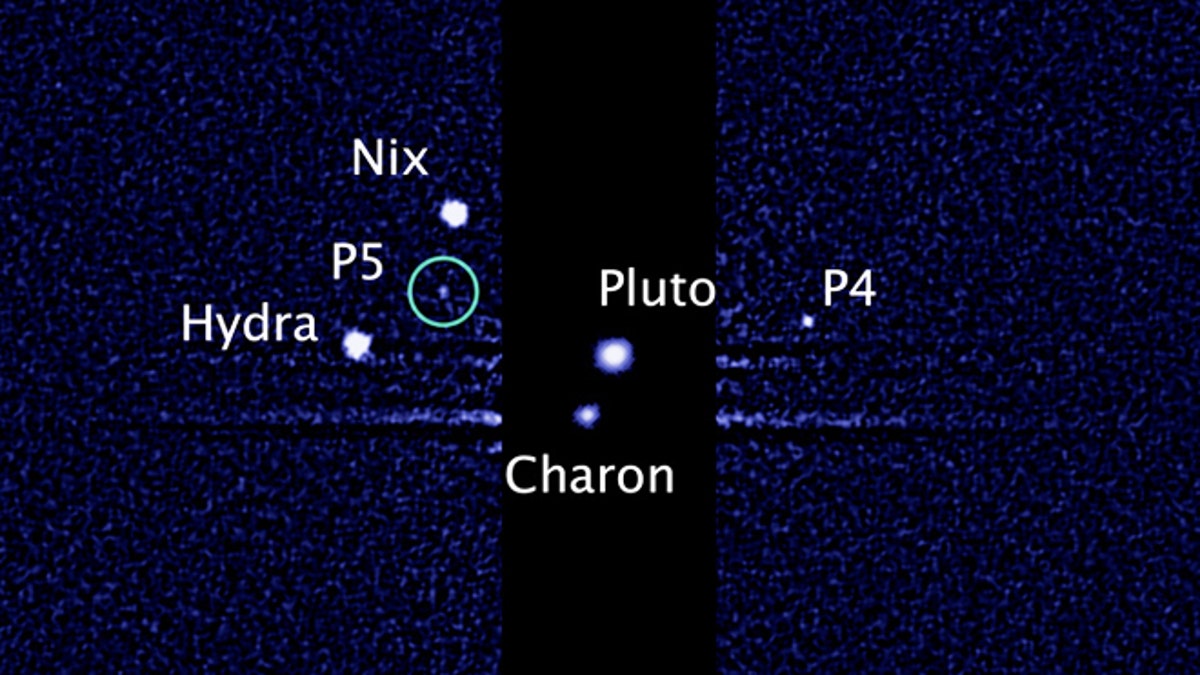
This image, taken by NASA's Hubble Space Telescope, shows five moons orbiting the distant, icy dwarf planet Pluto. The green circle marks the newly discovered moon, designated P5, as photographed by Hubble's Wide Field Camera 3 on July 7, 2012. (NASA, ESA, and M. Showalter (SETI Institute))
A flotilla of 10 or more tiny undiscovered moons might lurk in Pluto's orbit, complicating a spacecraft's planned flyby of the distant dwarf planet in 2015, new simulations suggest.
This preliminary finding could make life even more difficult for the team planning NASA's New Horizons mission, which is slated to take the first-ever up-close look at the Pluto system in July 2015. After Pluto's fifth known moon, a small satellite known as P5, was discovered last year, officials said they may need to redraw the spacecraft's path to avoid such obstacles.
"It has our attention," New Horizons principal investigator Alan Stern told SPACE.com via email, referring to the new research. He added he hasn't thoroughly analyzed the work yet.
[pullquote]
The study was submitted to The Astronomical Journal and is currently available on the prepublishing site Arxiv. [Photos: Pluto and its 5 Moons]
- NASA starts making plutonium again
- Ukrainian attack dolphins not roaming the seas for romance
- Physicists say they have found long-sought Higgs boson
- Coincidence? The 9 craziest cases of simultaneous invention
- Did astrobiologists find a space alien fossil? Probably not
- Wright brothers flew 2 years after Gustav Whitehead, researcher claims
Dusty mystery
The potential moons, which would each measure just 0.6 miles to 1.8 miles across, arose in a simulation looking at how Pluto's known small satellites came to be.
Earlier in Pluto's history, a dust cloud surrounded the dwarf planet. Researchers still aren't sure where that dust came from, though they have some ideas.
Pluto's largest moon Charon, for example, might have slammed into the dwarf planet, producing debris. Alternatively, Pluto's gravity could have swept up dust lingering from the protoplanetary disk that formed the solar system.
However the debris appeared, researchers believe Pluto's four known smaller moons — P4, Nix, P5 and Hydra — gradually formed as the dust collided and clumped together, forming bigger and bigger objects.
To watch that in action, one scientific duo implemented calculations they previously used to look at planet formation and the origins of objects in the Kuiper Belt, a gigantic collection of icy bodies beyond Neptune's orbit.
Likely invisible from Earth
The duo, led by Scott Kenyon of the Harvard-Smithsonian Center for Astrophysics, stepped their computer simulations through what happened after the debris was generated.
The computer program treats smaller particles statistically. Once objects get above a certain size, roughly 0.62 miles (1 km) across, then the program renders them individually.
That's when the tiny satellites pop up. It's hard to say how many there are, the researchers said, as it's difficult to simulate collisions among these tiny satellites. There could be anywhere from one to more than 10 objects lurking beyond Hydra's orbit.
While the team can simulate these satellites, they said it's unlikely they could be spotted (if they exist at all) from Earth.
The brightness of the potential objects dance with the edge of the Hubble Space Telescope's capabilities, Kenyon said, and they are likely beyond the reach of even the most sensitive ground-based telescopes, such as the Keck Observatory in Hawaii.
"Pluto is so bright," Kenyon said, explaining that the light washes out its satellites. "I don’t think a ground-based telescope would have a chance, and it’s at the limit of what HST can do."
New Horizons might be able to spot smaller satellites before it gets there, but Kenyon said he wasn't sure when the objects would appear big enough for the spacecraft to detect. The satellites would be "easily visible" during the spacecraft's closest approach to Pluto in 2015, the paper noted.
Implications for exoplanets
While the discovery of P4 (and, during their research, P5) motivated the scientists' look at the Pluto system, the research also has implications for understanding how exoplanets form around binary or double stars.
Pluto and Charon are so close in size that Pluto is often considered a binary dwarf planet. Since NASA's planet-hunting Kepler space telescope has found lots of planets around binary stars, modeling Pluto's system could be a "laboratory," Kenyon said, to understand how distant planets form as well.
"We would use the same machinery, the same kind of calculation, to make planets around binary stars as to make satellites around binary planets," he said. "It improves our understanding, and we can extend it to exoplanets."
As for how the dust came to be, Kenyon said New Horizons could solve that mystery. Charon is much brighter and icier than other Kuiper Belt objects. If Pluto's small moons look similar to Charon, they probably formed from a giant impact.
"New Horizons will have enough measurements to infer differences in composition in the satellites around Pluto-Charon," he said. "We’ll have a better idea of what the origin of the material is."




















